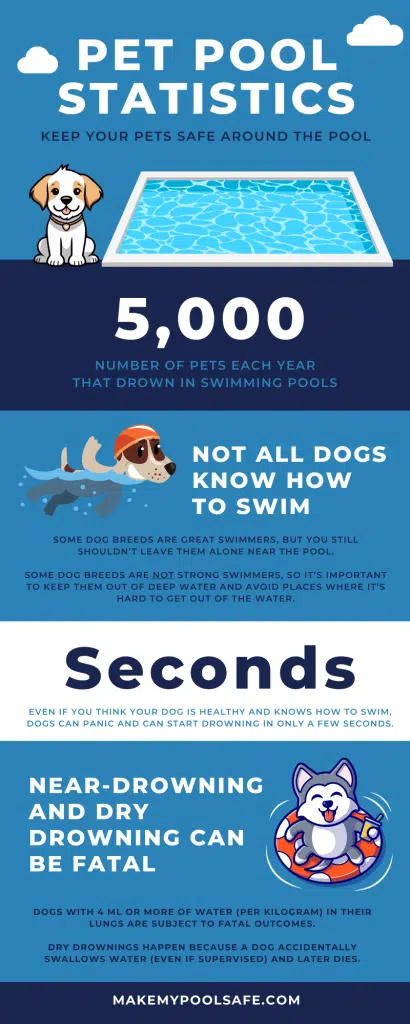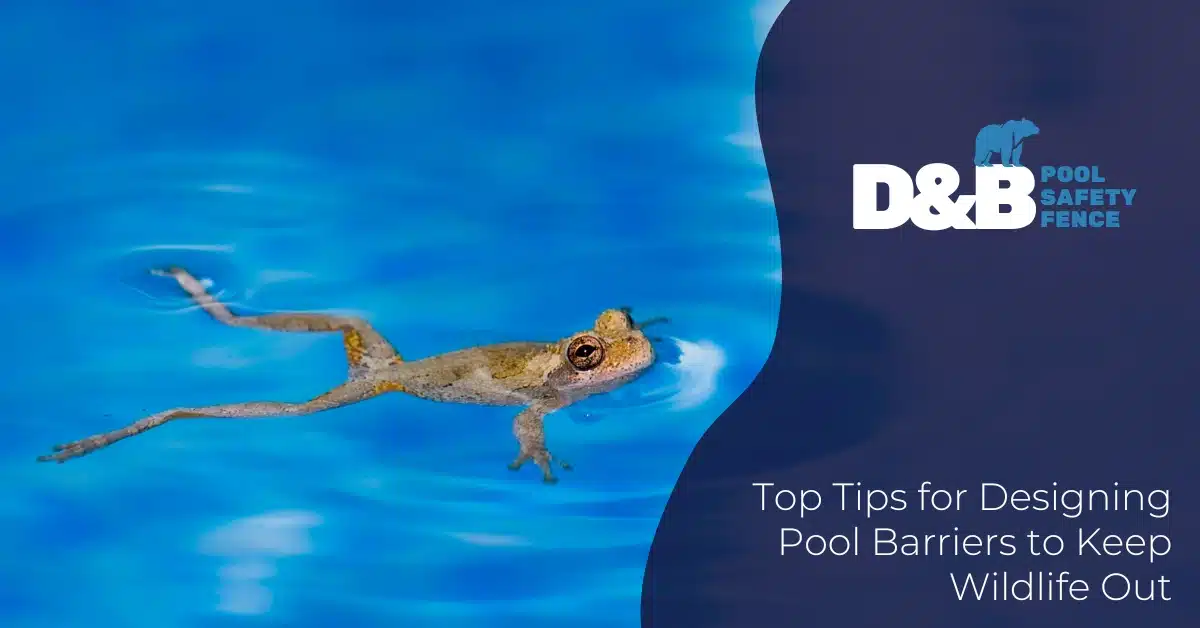Outdoor adventures bring joy for families and their pets, but it also brings unique safety challenges. Pools, while a source of recreation for humans, can be hazardous for our furry friends. To ensure your pets’ safety and peace of mind, it’s essential to take steps to protect them around the pool. In this article, we’ll provide tips on how to keep your pets secure near the pool, with a focus on the benefits of a swimming pool safety fence for pet owners.
Pool Hazards for Pets
Many pets are naturally drawn to water, and the sight and sounds of a pool can pique their curiosity. Dogs, in particular, might be tempted to explore the pool area and could accidentally fall in. Pools can pose various dangers to our beloved pets, including:
Drowning
Drowning is one of the most significant hazards a pool presents for pets. While some dogs are strong swimmers, not all animals possess the same natural instincts. Pets can easily slip or accidentally fall into the pool, leading to potentially life-threatening situations. It’s essential to remember that even good swimmers can become disoriented in unfamiliar pool environments.

Inadequate Swimming Skills
While some dogs are natural swimmers, not all pets possess the same swimming abilities. Even dogs with some swimming experience may struggle in a pool if they can’t find a way to exit.
Dog Breeds at Higher Risk for Inadequate Swimming Skills
Bulldog
Bulldogs, with their heavy, muscular bodies and short legs, are not built for swimming. Their body structure and brachycephalic (short-nosed) faces make it difficult for them to stay afloat. While some Bulldogs may enjoy a shallow dip to cool off, they should be closely supervised near water due to their limited swimming ability.
Pug
Pugs, similar to Bulldogs, have a brachycephalic facial structure and stout bodies. Their short legs and relatively small lung capacity can make swimming a challenge. Pugs are prone to fatigue in the water, and their flat faces can make it harder to keep their heads above the surface.
Basset Hound
Basset Hounds are known for their long bodies, short legs, and heavy bones. These characteristics, combined with their love of sniffing around, can lead to difficulties in swimming. They are more likely to sink than float, and their large, floppy ears can trap water and make it harder to stay afloat.
Dachshund
Dachshunds, also known as wiener dogs, have long, slender bodies and short legs. While they are playful and curious, their bodies are not designed for efficient swimming. Their risk of struggling in the water is particularly high, and they should be closely monitored near pools and other bodies of water.
French Bulldog
French Bulldogs share some similarities with their English Bulldog counterparts, including a brachycephalic face and a stout build. While they may enjoy wading in shallow water, their swimming abilities are generally limited. Like Bulldogs, they should be watched closely around water.
Chemical Exposure
Pool water is treated with chemicals like chlorine and algaecides to keep it clean. Pets, being naturally curious, might be tempted to drink from the pool or lick their wet fur. Ingesting pool water can lead to chemical poisoning and a host of health issues, from mild stomach upset to more severe complications.
Slippery Surfaces
Wet pool decks can be treacherous for pets, especially if they are running around excitedly. These surfaces can become extremely slippery, increasing the risk of injuries from slips and falls. Such accidents can result in broken bones, sprains, or other painful injuries for your pet.
Exhaustion
Pets may tire quickly in the water, especially if they are unable to find a way out. Fatigue can lead to them becoming disoriented and potentially drowning.
Sunburn
Pets, just like humans, can suffer from sunburn. Dogs with light-colored fur or those with short coats are particularly vulnerable to the harmful effects of prolonged sun exposure. Spending too much time by the pool can lead to sunburn and even skin cancer in the long run.
Entrapment and Pool Drains
Pets, particularly small dogs or cats, might be at risk of entrapment or injury by getting too close to pool drains. Suction from these drains can be powerful enough to trap a pet, leading to serious injuries or even drowning.

Pet Safety Guide – Preventing Pool Hazards for Pets
To keep your furry friends safe around the pool, follow these tips:
Supervision is Key
Supervision is the cornerstone of pet safety around the pool. Just as you would never leave a child unattended near water, the same rule applies to your pets. Whether it’s a dog, cat, or any other pet, keep a watchful eye on them while they’re near the pool. Even strong swimmers can experience difficulties, and it’s essential to be there to intervene in case of an accident.
Pool Safety Equipment
Invest in safety equipment designed for pets, such as life vests. These specially designed vests can provide added buoyancy and help your pets stay afloat. While some animals are natural swimmers, the extra security offered by a life vest can be a lifesaver.
Pool Safety Barriers
A pool fence is a robust barrier that can prevent pets from accessing the pool area unsupervised. Pool fences are particularly beneficial for pet owners with multiple pets or those who want to restrict access to the pool entirely. They offer peace of mind, ensuring that your pets remain safe even when you’re not around.
Swimming Lessons
If your pet enjoys the water, consider providing them with swimming lessons or a flotation device to ensure they can safely exit the pool.
Pet-Friendly Pool Ladders and Ramps
Consider installing pet-friendly pool exits such as ladders, ramps, or pet escape stairs. These specialized exits can make it easier for your pets to exit the pool if they accidentally fall in. By providing them with a designated way out, you reduce the risk of exhaustion and panic in the water.
Shade
Ensure your pets have access to shaded areas near the pool, especially during the hottest parts of the day. Just like humans, pets can get sunburned, so provide a place where they can rest and cool down.
Water Source
Always have fresh drinking water readily available to discourage them from drinking pool water, which can contain harmful chemicals.
Training
Teach your pets how to exit the pool safely by using the stairs or ramps.
Emergency Pet Care Around the Pool
If your pet does fall into the pool, or you notice strange behavior after you’ve been in the water with your pet, here are some emergency tips that can be lifesaving.
CPR and First Aid Training
In case of an emergency, knowing how to perform CPR or basic first aid for pets is crucial. While we hope you never have to use these skills, being prepared can be the difference between life and death for your beloved furry friend. You can take a pet first aid class to learn these lifesaving techniques.
Immediate Action
If your pet falls into the pool and is struggling or unable to get out, act immediately. Safely retrieve your pet from the water, supporting their head and neck. If your pet is not breathing, begin CPR or artificial respiration, then seek immediate veterinary assistance.
The Benefits of Pool Safety Fences for Pet Owners
One of the most effective ways to protect your pets around the pool is by installing a pool safety fence. Here are the benefits of this essential safety feature:
Physical Barrier
Drowning is a significant concern for pets around pools. Dogs, in particular, may be attracted to the water and could accidentally fall in, especially when chasing toys or exploring. Pool safety fences act as a physical barrier, effectively preventing pets from gaining access to the pool area without supervision. This fundamental protection helps to reduce the risk of accidental drowning of dogs and other pets.
Peace of Mind
One of the primary benefits of a pool safety fence is the peace of mind it provides. When you have a pool safety fence in place, you can enjoy your outdoor space without the constant worry of your pets getting too close to the pool. Knowing that they are safely confined to the designated areas of your yard, you can relax and enjoy your pool and surroundings.
Customization
Pool safety fences come in various materials and styles, allowing you to choose one that complements your backyard aesthetics while serving its primary purpose. Whether you prefer a classic look with wrought iron or a more modern and transparent option with glass fencing, there are numerous styles to fit your taste and needs.
Compliance
Many local and regional laws require pool owners to install safety barriers, including fences, to prevent unauthorized access to pools. By installing a pool safety fence, you not only protect your pets but also ensure you comply with these regulations. Failing to meet these requirements can result in legal consequences, so it’s a responsible choice for any pet owner.
Versatility
Pool safety fences can be both permanent and temporary, providing flexibility for pet owners. If you only want the fence during the swimming season, you can choose a removable or retractable option, giving you the freedom to open up your pool area when not in use. Although, it’s just as important to keep your pets safe from the pool in the off-season.
Pool safety for pets is of paramount importance for responsible pet owners. By following the tips mentioned above, you can create a secure, enjoyable environment for both your family and your pets. Keep in mind that while pool safety fences are a significant step in safeguarding your pets, your presence and supervision remain the most critical components in keeping them secure around the pool. To learn more about pool safety tips, read our top 10 pool safety tips every homeowner should know.






